Virginia Women's Monument
The Virginia Women's Monument is a state memorial in Richmond, Virginia commemorating the contributions of Virginia women to the history of the Commonwealth of Virginia and the United States of America.[1] Located on the grounds of the Virginia State Capitol, the monument is officially titled Voices from the Garden: The Virginia Women's Monument and features life-sized bronze statues of seven Virginia women placed in a small granite plaza.[2]
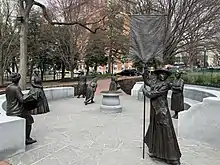 | |
 Location in Virginia  Virginia Women's Monument (the United States) | |
| Coordinates | 37°32′22″N 77°26′4″W |
|---|---|
| Location | 1000 Bank St, Richmond, VA 23219 |
| Material | Granite, bronze, glass |
| Opening date | October 14, 2019 |
| Dedicated to | Contributions of women throughout Virginia history |
| Official website | |
The monument was first proposed in 2009[3] and established by joint resolution of the Virginia General Assembly in 2010.[1] An 18-member commission, along with input from the Library of Virginia and professors of women's history, selected the women to be honored with statues sculpted by StudioEIS in Brooklyn, New York. The granite plaza and Wall of Honor were opened in October 2018 and the monument was officially unveiled with the first seven completed statues on October 14, 2019.[4]
The women currently featured include Cockacoeske, chieftain of the Pamunkey tribe; Anne Burras Laydon, Jamestown colonist; Mary Draper Ingles, famed frontierswoman and American pioneer; Elizabeth Keckley, seamstress and confidant of Mary Todd Lincoln; Laura Copenhaver, entrepreneur; Virginia Randolph, prominent educator; and Adele Goodman Clark, suffragist and activist.[4]
History
Proposal
The idea for the monument first came in 2009 from Richmond native Em Bowles Locker Alsop — a writer and former actress who had once been considered for the role of Scarlett O'Hara in the 1939 film Gone with the Wind.[3][5] Alsop lobbied her state senator, Walter Stosch, who subsequently introduced Senate Joint Resolution No. 11 in the 2010 session of the Virginia General Assembly.[6] The joint resolution, which created the Virginia Women's Monument Commission, was passed unanimously in both the Virginia House of Delegates and Senate of Virginia.[7] In 2015, Alsop died at the age of 98, three years before the monument was first opened to the public.[5]
From the text of Senate Joint Resolution No. 11:
WHEREAS, throughout the ages women have been central to the perpetuation of society, and women of every nationality and race have left an indelible mark through their countless contributions, achievements, and accomplishments that have benefitted mankind; and
WHEREAS, from the founding of the Commonwealth, the genius and creativity of women and their presence and contributions have been evident in every aspect of Virginia history and the life of the people of the Commonwealth; however, they have received little appreciation, recognition, or official acknowledgement...
RESOLVED by the Senate, the House of Delegates concurring, That a commemorative commission to honor the contributions of the women of Virginia with a monument on the grounds of Capitol Square be established.[1]
The joint resolution established that the Virginia Women's Monument Commission would be composed of 19 members—the Governor, the Chair of the Senate Committee on Rules, the Speaker of the House of Delegates, representatives from the Senate and House, the Clerk of the House, and eight members of the general public. The resolution also established that the monument would be built with private funds.[7]
Design

When completed, the monument is planned to have a total of 12 statues, chosen from every region of the state and representing the diverse achievements of women throughout the first 400 years of Virginia's history. Standing in the center of the plaza is a granite pedestal topped by a bronze sundial engraved with the names of several Virginia localities.[2] Two benches line the sides of the oval plaza, along with a series of tempered glass panels inscribed with the names of more than 200 additional important women of Virginia history called the Wall of Honor.[8]
Statues
Current monument
| Honoree | Picture | Lived | Region | Description |
|---|---|---|---|---|
| Anne Burras Laydon |  |
before c. 1594 - after 1625 | Jamestown | Colonist |
| Cockacoeske | 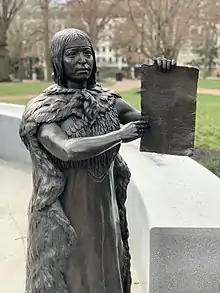 |
fl. 1656-1686 | Middle Peninsula | Pamunkey chief |
| Mary Draper Ingles | 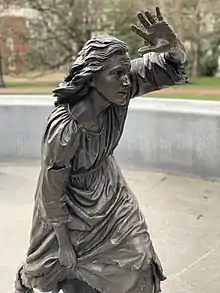 |
1732-1815 | New River Valley | Frontierswoman |
| Elizabeth Keckley | 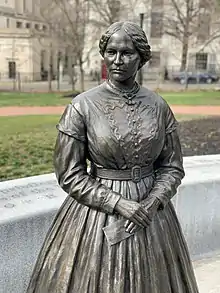 |
1818-1907 | Dinwiddie County | Seamstress and author |
| Laura E. Copenhaver | 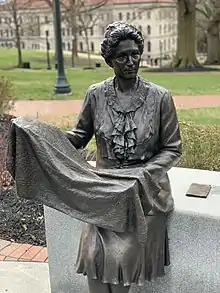 |
1868-1940 | Smyth County | Entrepreneur and Lutheran lay leader |
| Virginia E. Randolph | 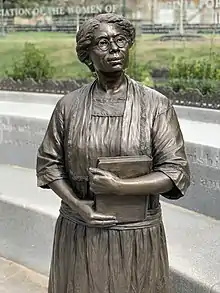 |
1870-1958 | Henrico County | Educator |
| Adèle Clark |  |
1882-1983 | Richmond | Suffragist and artist |
Wall of Honor
A further 230 women are listed on the Wall of Honor of the Monument; further nominations are currently being solicited.[9]
List of honorees
- Em Bowles Locker Alsop
- Pocahontas (Matoaka)
- Pauline F. Adams
- Mollie Adams
- Lucy Addison
- Mary Aggie
- Ella G. Agnew
- Mary C. Alexander
- Sharifa Alkhateeb
- Susie M. Ames
- Eleanor Copenhaver Anderson
- V. C. Andrews
- Orie Moon Andrews
- Ann (Pamunkey chief)
- Grace Arents
- Nancy Astor
- Addie D. Atkinson
- Anne Bailey
- Odessa P. Bailey
- Mary Julia Baldwin
- Lucy Barbour
- Hazel K. Barger
- Janie Porter Barrett
- Kate Waller Barrett
- M. Majella Berg
- Frances Berkeley
- Ann Bignall
- Aline E. Black
- Mary Blackford
- Catherine Blaikley
- Florence A. Blanchfield
- Anna Bland
- Cynthia Boatwright
- Elisabeth S. Bocock
- Anna W. Bodeker
- Carrie J. Bolden
- Mary Marshall Bolling
- Matilda M. Booker
- Gladys Boone
- Dorothy Rouse Bottom
- Geline MacDonald Bowman
- Mary Richards Bowser
- Rosa D. Bowser
- Belle Boyd
- Sarah Patton Boyle
- Mildred Bradshaw
- Lucy Goode Brooks
- Belle S. Bryan
- Mary E. Brydon
- Annabel Morris Buchanan
- Dorothea D. Buck
- Pattie Buford
- Evelyn T. Butts
- Mary Willing Byrd
- Sadie Heath Cabaniss
- Mary Virginia Ellet Cabell
- Willie Walker Caldwell
- Edith Lindeman Calisch
- Christiana Campbell
- Elizabeth Pfohl Campbell
- Eliza J. Carrington
- Maybelle Carter
- Sara Carter
- Virginia Cary
- Ruth Harvey Charity
- Jean Outland Chrysler
- Patsy Cline
- Matty L. Cocke
- Sarah Johnson Cocke
- Naomi Silverman Cohn
- Cynthia B. T. Coleman
- Edna M. Colson
- Esther I. Cooper
- Hannah Lee Corbin
- Ann Cotton
- Lucy Ann Cox
- Daphne Dailey
- Margaret Dashiell
- Jo Ann Davis
- Grace E. Davis
- Jennie Dean
- Helen Dewar
- Emily W. Dinwiddie
- Claudia Dodson
- Bertha L. Douglass
- M. Estelle Eley
- Virginia Randolph Ellett
- Margaret Erskine
- Lettie Pate Whitehead Evans
- Sarah Lee Fain
- Lillie Fearnow
- Rachel Findlay
- Edith Fitzgerald
- Ella Fitzgerald
- Eve D. Fout
- Ethel Bailey Furman
- Elizabeth Furness
- Mary Jeffery Galt
- Charlotte C. Giesen
- Ellen Glasgow
- Meta Glass
- Thelma Young Gordon
- Nancy Hale
- India Hamilton
- Dorothy Hamm
- Marion Harland
- Laura Jane Harper
- Jean Harris
- Orie Latham Hatcher
- Della I. Hayden
- Mary Rice Hayes-Allen
- Sally Hemings
- Rachel Henderlite
- Helen T. Henderson
- Susanne Hirt
- Ann Makemie Holden
- Judith Hope
- Grace Hopper
- Nora Houston
- Mary W. Jackson
- Annabella R. Jenkins
- Kate Jeter
- Florence Jodzies
- Barbara Johns
- Julia Johns
- Mary Johnston
- Mary Johnston-Brittain
- Georgeanna Jones
- Thomasina E. Jordan
- Ona Judge
- May L. Keller
- Emma V. Kelley
- Christine Herter Kendall
- Lucille Chaffin Kent
- Elizabeth Key
- Ellen G. Kidd
- Alice Kyle
- Henrietta Lacks
- Anna Maria Lane
- Orra Langhorne
- Irene Leache
- Edna Lewis
- Elizabeth D. Lewis
- Matilda Lindsay
- Judith Lomax
- Rebecca Lovenstein
- Louise O'Connor Lucas
- Mary Tyler Cheek McClenahan
- Dorothy S. McDiarmid
- Sarah Madden
- Dolley Madison
- Pauline F. Maloney
- Miriam D. Mann
- Bessie N. Marshall
- Lucy Randolph Mason
- Vivian Carter Mason
- Amaza Lee Meredith
- Alice duPont Mills
- Jane Minor
- Nannie J. Minor
- Lottie Moon
- Undine Smith Moore
- Georgia Weston Morgan
- Irene Morgan
- Mary-Cooke Branch Munford
- Elizabeth Nottingham
- Opossunoquonuske
- Elizabeth L. Otey
- Mary Morton Parsons
- Nina K. Peace
- Mary Peake
- Rebekah Peterkin
- Marian Poe
- Theresa Pollak
- Amelia E. P. Pride
- Orleana Puckett
- Caroline F. Putnam
- Mary Randolph
- Jessie M. Rattley
- Eudora Ramsay Richardson
- Isabel Rogers
- Wané Roonseraw
- Dorothy Roy
- Elizabeth Russell
- Nellie Pratt Russell
- Marion duPont Scott
- Mary Wingfield Scott
- Eleanor P. Sheppard
- Grace Sherwood
- Catherine Filene Shouse
- Henrietta Shuck
- Jean Skipwith
- Isabel Dodge Sloane
- Louise J. Smith
- Anne Spencer
- Elizabeth Allen Smith
- Annie Snyder
- Ora B. Stokes
- Kathryn H. Stone
- Queena Stovall
- Mary C. Stowers
- Alice Jackson Stuart
- Kate Peters Sturgill
- Evelyn Reid Syphax
- Elizabeth N. Tompkins
- Amélie Rives Troubetzkoy
- Lucile Barrow Turner
- Lila Meade Valentine
- Elizabeth Van Lew
- Mary B. Wade
- Mabel Lee Walton
- Melissa Warfield
- Laura Martin Wheelwright
- Edith Bolling Wilson
- Jean Wood
- Helen Wood
- Temperance Flowerdew Yeardley
- Martha Anne Woodrum Zillhardt
References
- "Senate Joint Resolution No. 11". Virginia's Legislative Information System. Virginia Division of Legislative Automated Systems. Retrieved 15 February 2020.
- "About Us: Voices from the Garden". Virginia Women's Monument Commission. Virginia Women's Monument Commission. Retrieved 15 February 2020.
- Curran, Colleen (2019-10-14). "'A monumental day': Seven statues unveiled at Virginia Women's Monument on Capitol Square". Richmond Times-Dispatch. Retrieved 2020-02-15.
- "Voices from the Garden: The Virginia Women's Monument is Nation's First Monument Honoring Full Scope of Women's Achievements" (PDF). Virginia Women's Monument Commission. 2019-10-01.
- Robertson, Ellen (2015-03-08). "Em Bowles Locker Alsop, one of 20 screen-tested to be Scarlett O'Hara in GWTW, dies at 98". Richmond Times-Dispatch. Richmond Times-Dispatch. Retrieved 2020-05-16.
- "Obituary for Em Bowles Locker Alsop at Central Chapel". www.bennettfuneralhomes.com. Retrieved 2020-02-23.
- "LIS > Bill Tracking > SJ11 > 2010 session". lis.virginia.gov. Retrieved 2020-02-23.
- "Wall of Honor". Virginia Women's Monument Commission. Virginia Women's Monument Commission. Retrieved 15 February 2020.
- "Virginia Womens Monument Commission". womensmonumentcom.virginia.gov.